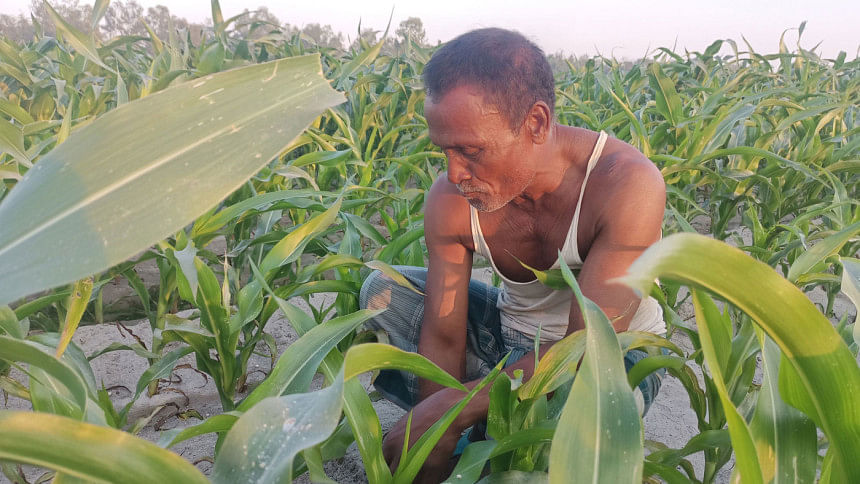Dried-up Teesta riverbed green with maize cultivation

Farmers are expecting bumper production of maize cultivated on the dried-up Teesta riverbed and char lands in Lalmonirhat district this season.
The growing crop has worn eye-catching looks with layers of lush green leaves of the tall maize plants soothing the eyes. Cultivation of maize has been proven to be a game-changer for the char farmers. This year vast tracts of sandy land have been brought under maize cultivation and the farmers are expecting a bumper yield.
As other crops did not yield on the sandy land as expected, farmers have leaned on maize cultivation. Farmers do not have to worry about selling their produce as different feed companies buy maize directly from the farmers.
According to Lalmonirhat Agriculture Department sources, maize has been cultivated on 35,300 hectares of land in five upazilas of Lalmonirhat this year. Last year, the crop was cultivated on 34,750 hectares of land. Maize has been cultivated mostly on the dried-up Teesta riverbed and along the river banks.
Zahurul Haque, 60, a farmer from Char Sindurna area in Hatibandha upazila, said that he has cultivated maize on 195 decimals of land on the Teesta riverbed this year. Last year, he cultivated the crop on 170 decimals of land.
The cost of seeds, fertiliser and labour will stand at Tk 60-65 thousand. He will get 50-55 kg of maize from each decimal of land. He expects to sell each maund of maize (40 kg) for Tk 720-800.
"For the last 15 years, I have been cultivating maize on the Teesta char. At first, I did not have the desired output but now I'm getting a bumper yield," he said.
"Maize cultivation on sandy soil has changed our destiny,'" he added.
Montaz Ali, 62, a farmer of Teesta Char Kuchalibari in Patgram upazila, said that vast tracts of char land would lie barren before the maize cultivation began in the char area. "We are getting the desired yield and price of maize. It is the only means of our survival," he said.
"Last year, I planted maize on eight bighas of land and it is now ten bighas this year," he said, adding, that "We hope to get the same yield and price as last year."
Shamim Ashraf, deputy director of Department of Agriculture Extension (DAE) in Lalmonirhat, said that about 40,000 farmers in the district were reaping direct benefits from maize cultivation. Especially, the char farmers are benefiting more. Maize cultivation starts from mid-November and is harvested from mid-April. The cultivation does not cost much.
"We are giving guidance and providing technical know-how to the farmers on maize cultivation," he added.

 For all latest news, follow The Daily Star's Google News channel.
For all latest news, follow The Daily Star's Google News channel. 



Comments